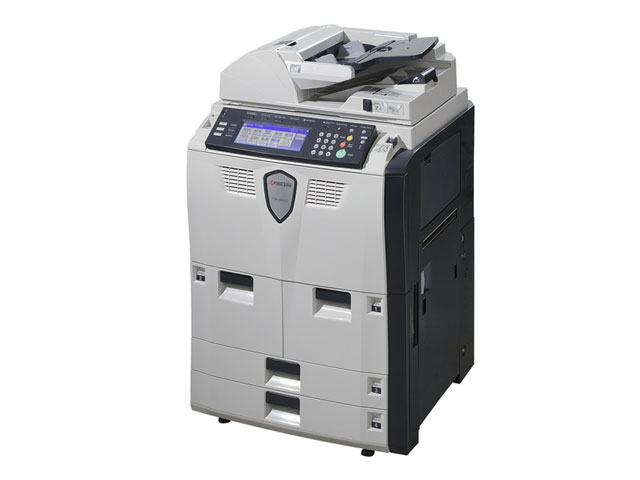Kyocera Mita KM-8030 review
If your business needs include high volume speedy A3 printing, this Kyocera deserves consideration.

This is more than just a printer; it's a document management system. Thanks to its versatile scanning and copying facilities, its extensive collation and finishing options and its impressive speed and flexibility it will certainly improve in-house document production in a busy corporate department or reprographics business.
Despite its functionality and price, the printer can be connected via ubiquitous USB 2.0 or parallel cables, as well as to a 10/100 Ethernet network. Kyocera's drivers are straightforward to install and give full functionality. There's also a network device monitor supplied, so IT staff can check the machine's status from any networked PC.
It's hard to believe the 80ppm speed quoted by Kyocera Mita, but under test, we saw it complete a 60-page, single-sided job in 62 seconds, which gives three quarters of this. Duplex print takes very little longer, and our 60-side job took just 69 seconds. Moving to A3 paper saw a 20-side job finish in 50 seconds, again a fairly spectacular speed. Copy speeds are also good, with a 20-page, A4 print taking 22 seconds and a 20-side duplex one completing in just three seconds longer.
The quality of prints from the machine is fair. Text prints are dense and well-formed, with even small point sizes coming through clearly. Business graphics are OK, though there's a degree of graininess in areas of greyscale and some banding, particularly where there are varying greyscale tints.
This is emphasised in the photo prints we produced, where detail was generally good, even in areas of dark shadow, but where the variegated sky is full of light and dark bands. Kyocera claimed the test machine might have needed adjusting and that they would have expected less banding than we saw.
Like many Kyocera Mita printers, the KM-8030 has a lifetime drum, good for over a million copies or prints. This means the only consumables are a toner cartridge - rated at 47,000 pages - and a preventive maintenance kit, which is needed every 500,000 pages. The best prices we could find for these, result in a cost per page of 0.175p, with bulk costs (on contract) even lower, at 0.149p. This is a very good page cost and maintains the company's reputation for low overall cost of ownership.
Although the KM-8030 is well equipped from the off, there are numerous options to expand its paper handling and collation facilities. These range from a six-bin output sorter, to a stapler and hole punch, to a 1,000 sheet feeder, for those with very heavy usage. The machine has a maximum duty cycle of 400,000 pages per month, but a usage figure of 80,000 is more typical. With these options installed, it's quite possible to print stapled booklets with separate coloured covers and flyleaves in a single job.
Verdict
This is more than just a printer; it's a document management system. Thanks to its versatile scanning and copying facilities, its extensive collation and finishing options and its impressive speed and flexibility it will certainly improve in-house document production in a busy corporate department or reprographics business.
DPI: 600dpi, 80ppm A3 document manager Paper handling: 2 x 1,500 + 2 x 500-sheet paper trays + 150-sheet multi-purpose Duty cycle: 400,000 page monthly duty cycle Scanner: 200-sheet, duplex ADF scanner Connectivity: USB 2.0, Ethernet and parallel ports Drivers: Prescribe driver plus PCL6 and PostScript L3 emulation Extra: Extensive paper-handling options
Get the ITPro daily newsletter
Sign up today and you will receive a free copy of our Future Focus 2025 report - the leading guidance on AI, cybersecurity and other IT challenges as per 700+ senior executives
-
 CyberOne appoints Microsoft’s Tracey Pretorius to its advisory board
CyberOne appoints Microsoft’s Tracey Pretorius to its advisory boardNews The threat intelligence leader will provide strategic guidance to CyberOne’s executive team
By Daniel Todd Published
-
 CISA issues warning in wake of Oracle cloud credentials leak
CISA issues warning in wake of Oracle cloud credentials leakNews The security agency has published guidance for enterprises at risk
By Ross Kelly Published
-
 Reports: White House mulling DeepSeek ban amid investigation
Reports: White House mulling DeepSeek ban amid investigationNews Nvidia is caught up in US-China AI battle, but Huang still visits DeepSeek in Beijing
By Nicole Kobie Published